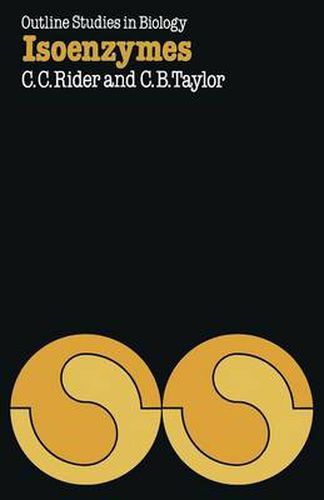Readings Newsletter
Become a Readings Member to make your shopping experience even easier.
Sign in or sign up for free!
You’re not far away from qualifying for FREE standard shipping within Australia
You’ve qualified for FREE standard shipping within Australia
The cart is loading…






This title is printed to order. This book may have been self-published. If so, we cannot guarantee the quality of the content. In the main most books will have gone through the editing process however some may not. We therefore suggest that you be aware of this before ordering this book. If in doubt check either the author or publisher’s details as we are unable to accept any returns unless they are faulty. Please contact us if you have any questions.
Isoenzymes were ‘discovered’ 20 years ago and were at first regarded as interesting but rare occurrences. Since then a wealth of information on enzyme heterogeneity has accrued and it now seems likely that at least half of all enzymes exist as isoenzymes. This is important in many areas of biological and medical science. Thus isoenzyme studies have provided the main experimental substance for the neutral drift controversy in genetics and evolution; they have greatly extended our understanding of metabolic regulation not only in animals but also in bacteria and plants; their existence has made available a multitude of highly sensitive markers for the study of differentiation and development, as well as providing indices of aberrant gene expression in carcinogenesis and other pathological processes. Iso enzymes are also being used increasingly in diagnostic clinical bio chemistry. It is surprising that this phenomenon which affects such a high pro portion of enzymes and is clearly important in biochemistry should receive such scant attention in the standard textbooks of that subject, the formal treatment of isoenzymology in these rarely exceeding one or two pages. This may be because the ‘pure biochemist’ has tended to regard variation in enzyme properties between tissues more as an unwanted complication than as a potential source of insight into diversity of biological function.
$9.00 standard shipping within Australia
FREE standard shipping within Australia for orders over $100.00
Express & International shipping calculated at checkout
This title is printed to order. This book may have been self-published. If so, we cannot guarantee the quality of the content. In the main most books will have gone through the editing process however some may not. We therefore suggest that you be aware of this before ordering this book. If in doubt check either the author or publisher’s details as we are unable to accept any returns unless they are faulty. Please contact us if you have any questions.
Isoenzymes were ‘discovered’ 20 years ago and were at first regarded as interesting but rare occurrences. Since then a wealth of information on enzyme heterogeneity has accrued and it now seems likely that at least half of all enzymes exist as isoenzymes. This is important in many areas of biological and medical science. Thus isoenzyme studies have provided the main experimental substance for the neutral drift controversy in genetics and evolution; they have greatly extended our understanding of metabolic regulation not only in animals but also in bacteria and plants; their existence has made available a multitude of highly sensitive markers for the study of differentiation and development, as well as providing indices of aberrant gene expression in carcinogenesis and other pathological processes. Iso enzymes are also being used increasingly in diagnostic clinical bio chemistry. It is surprising that this phenomenon which affects such a high pro portion of enzymes and is clearly important in biochemistry should receive such scant attention in the standard textbooks of that subject, the formal treatment of isoenzymology in these rarely exceeding one or two pages. This may be because the ‘pure biochemist’ has tended to regard variation in enzyme properties between tissues more as an unwanted complication than as a potential source of insight into diversity of biological function.